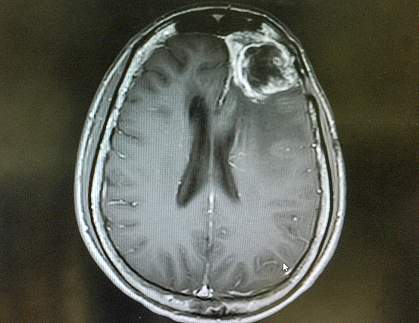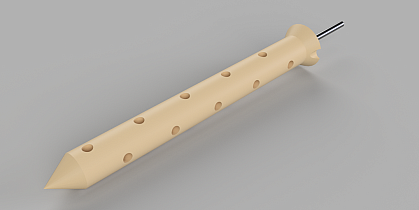You are here
September 19, 2023
Tiny implanted devices give insights for treating brain tumors
At a Glance
- A tiny device implanted during brain surgery could help provide personalized information about a tumor’s potential responses to cancer-fighting drugs.
- The findings from this small clinical trial hold promise for developing personalized post-surgery treatments for aggressive brain cancers.

Hard-to-treat tumors known as gliomas originate in the brain or spinal cord. The subtype known as glioblastoma is the most common type of primary brain cancer in adults, and is especially aggressive. Affected patients usually have surgery to remove the tumor, followed by chemotherapy or radiation to eliminate any remaining cancer cells. Despite years of research, no biomarkers have been identified to help guide targeted treatment strategies. Unfortunately, survival rates for people with glioblastoma have not significantly improved over the past decades.
A research team led by Drs. Pierpaolo Peruzzi and Oliver Jonas of Brigham and Women’s Hospital developed and tested a novel approach for assessing how well various antitumor drugs might work for each patient. The scientists created tiny drug-releasing microdevices—each about the size of a grain of rice—that can be inserted into a patient’s tumor at the start of brain surgery. The device releases tiny “nano-doses” of anti-cancer drugs at separate locations within the tumor. The drugs then incubate in the patient’s tumor as the brain surgery proceeds for another two to three hours.
The microdevices are removed with the last piece of the tumor. The tissue can then be analyzed to assess the effects of various drugs. This type of technology is sometimes called “lab in a patient,” as it’s designed to simultaneously screen and evaluate multiple treatments within the patient’s body.
In a first-in-human clinical trial, the researchers assessed the safety of this approach in six patients with glioma. Participants ranged in age from 27 to 85. Five had been diagnosed with glioblastoma, and the other with an aggressive astrocytoma. The researchers followed standard surgical workflow for these types of cancers other than the insertion of the devices. Results were described in Science Translational Medicine on September 6, 2023.

The pilot study found that the insertion and removal of the microdevices was safe. It added addition time to the surgeries—an average of 32 minutes—but no additional time to the intensive care unit or hospital stays. No related adverse events were reported in the three days after surgery or at follow-up about 12 and 30 days later.
This phase 1 clinical trial was not designed to help guide treatment strategies. But it did find preliminary evidence that the microdevices could help to identify a patient’s potential responses to various drugs. All of the drugs loaded into the devices were released into confined regions of the tumor. The tissues were exposed to the drugs for about 2 hours. Afterward, they were analyzed for sensitivity to each drug.
“It’s important that we are able to do this in a way that best captures the features of each patient’s tumor and, at the same time, is the least disruptive of the standard of care,” Peruzzi says. “This is not in the lab and not in a petri dish. It’s actually in real patients in real time, which gives us a whole new perspective on how these tumors respond to treatment.”
Although several drugs were tested in the device, only one was administered to the patients. Further studies will be needed to test how effective the microdevices could be in guiding personalized cancer treatments.
—by Vicki Contie
Related Links
- Customized Drug to Kill Brain Cancer Cells
- Delivering RNA Therapies to Brain Tumors
- How Cancer Vesicles Breach the Blood-Brain Barrier
- Brain and Spinal Cord Tumors
- Brain Tumors
- Brain Tumor Clinic at NIH
References: Intratumoral drug-releasing microdevices allow in situ high-throughput pharmaco phenotyping in patients with gliomas. Peruzzi P, Dominas C, Fell G, Bernstock JD, Blitz S, Mazzetti D, Zdioruk M, Dawood HY, Triggs DV, Ahn SW, Bhagavatula SK, Davidson SM, Tatarova Z, Pannell M, Truman K, Ball A, Gold MP, Pister V, Fraenkel E, Chiocca EA, Ligon KL, Wen PY, Jonas O. Sci Transl Med. 2023 Sep 6;15(712):eadi0069. doi: 10.1126/scitranslmed.adi0069. Epub 2023 Sep 6. PMID: 37672566.
Funding: NIH’s National Cancer Institute (NCI) and National Institute of Biomedical Imaging and Bioengineering (NIBIB).
